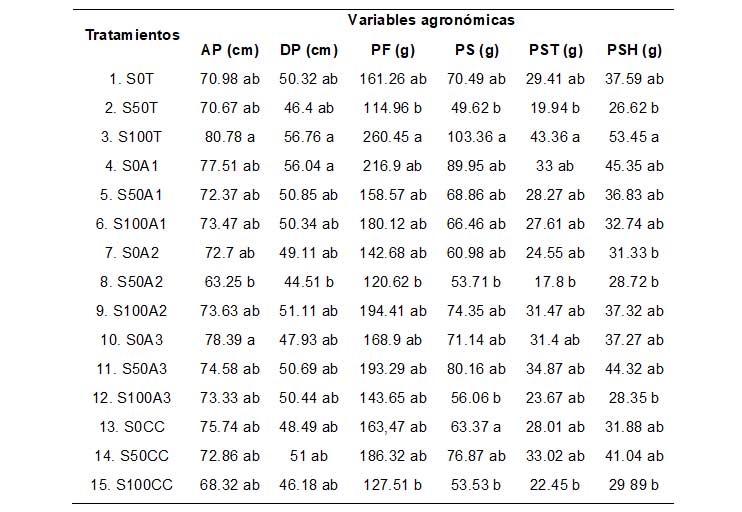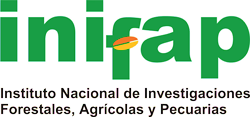Biomasa y minerales en Lippia graveolens bajo tres ambientes de producción en General Cepeda
DOI:
https://doi.org/10.29312/remexca.v16i1.3214Palabras clave:
agricultura protegida, nutrición orgánica, orégano, rizobacteriasResumen
El orégano (Lippia graveolens) de la familia Verbenaceae, es una planta aromática que se distribuye en regiones áridas y semiáridas de México, se utiliza como condimento de alimentos, elaboración de cosméticos, fármacos y licores, motivos que lo convierten en un producto de exportación. Con el propósito de determinar el mejor ambiente y tipo de fertilización que promueva las variables agronómicas, se estableció el objetivo de evaluar la producción de biomasa y concentración de minerales en tres ambientes de cultivo: invernadero, malla sombra y campo abierto y tratamientos con fertilización química con solución Steiner (SS) (0%, 50% y 100%) y biológica (cuatro cepas de Azospirillum spp), en un arreglo factorial de 3 x 5, con un total de 15 tratamientos en cada ambiente. El trabajo se inició en Julio de 2019, en General Cepeda, Coahuila. El ambiente con mayores valores de producción fue INV con: DP (57.56 cm), PF (240.94 g), PS (79.86 g), PST (34.35 g) y PSH (41.26 g). El T3 (SS 100%, sin Azospirillum sp.) resultó con mejores valores de AP (80.78 cm), DP (56.76 cm), PF (260.45 g), PS (103.36 g), PST (43.36 g) y PSH (53.45 g). Para minerales el ambiente de MS resultó ser mejor en N y K con 14 451.1 y 9 108.1 mg kg-1 respectivamente y el INV para: P (4 206.95), Ca (17 486.5), Mg (1 741.11), Cu (8.24) y Zn (31.49) mg kg-1.
Descargas
Citas
Alcántar-González, G. y Sandoval-Villa, M. 1999. Manual de análisis químico de tejido vegetal. Guía de muestreo, preparación, análisis e interpretación. Publicación especial, 10. Sociedad Mexicana de la Ciencia del Suelo. Chapingo, Texcoco, Estado de México, México. 155 p.
Antal, D. S.; Citu, C.; Ardelean, F.; Dhelean, C.; Vlaia, L.; Soica, C.; Vlaia, V.; Biris, M. and Sas, I. 2015. Metallome of Origanum vulgare: the unknown side of a medicinal and aromatic plant used worldwide. Farmacia. 63(4):534-538.
Arzansh, M. H.; Benny, N. A.; Ghorbanly, M. L. and Shahbazi, M. 2012. Effect of plant growth promoting rhizobacteria on growth parameters and levels of micronutrient on rapeseed cultivars under salinity stress. Electronic Journal of Soil Management and Sustainable Production. 2(2):153-163. https://ejsms.gau.ac.ir/issue-24-143.html?lang=en.
Bremner, J. M. and Mulvaney, C. S. 1982. Nitrogen-total. In ‘methods of soil analysis. Part 2. Chemical and microbiological properties’. Ed. American Society of Agronomy, Soil Science Society of America: Madison, WI, USA. 595-624 pp. Doi: https://doi.org/10.2134/agronmonogr9.2.2ed.c31.
Conti, M. E. 2004. Dinámica de la liberación y fijación de potasio en el suelo. Informaciones Agronómicas del Cono Sur. IPNI. INPOFOS. 8(1):25-37. http://lacs.ipni.net/article/LACS-1090.
Corella-Bernal, R. A. y Ortega-Nieblas, M. M. 2013. Importancia del aceite esencial y la producción de orégano Lippia palmeri Watson en el Estado de Sonora. Biotecnia. 15(1):57-64. Doi: https://doi.org/10.18633/bt.v15i1.137.
Dunford, N. T. and Silva-Vazquez, R. 2005. Effect of water stress on plant growth and thymol and carvacrol concentrations in Mexican oregano grown under controlled conditions. Journal of Applied Horticulture. 7(1):20-22.
Flores-Hernández, A.; Hernández-Herrera, J. A.; López-Medrano, J. I.; Valenzuela-Núñez, L. M.; Martínez-Salvador, M. y Madinaveitia-Ríos, H. 2011. Producción y extracción de aceite de orégano (Lippia graveolens Kunth.) bajo cultivo en la Comarca Lagunera. Revista Mexicana de Ciencias Forestales. 2(3):113-120.
Fukalova, F. T.; Brito, B. G.; Novoa, T. C.; Sagñay, E. T.; Samaniego, I. M.; Tacán, M. P. y Tapia, I. C. 2021. Análisis comparativo de las propiedades fisicoquímicas y capacidad antioxidante de un morfotipo de orégano (Origanum vulgare L.) cultivado en dos localidades de la sierra ecuatoriana. Siembra. 8(1):1-10. https://doi.org/10.29166/siembra.v8i1.2289.
García-Pérez, E.; Castro-Álvarez, F. F.; Gutiérrez-Uribe, J. A. y García-Lara, S. 2012. Revisión de la producción, composición fitoquímica y propiedades nutracéuticas del orégano mexicano. Revista Mexicana de Ciencias Agrícolas. 3(2):339-353.
García, E. 2004. Modificaciones al sistema de clasificación climática de Köppen. Universidad Nacional Autónoma de México (UNAM). 13-165 pp.
Hanway, J. J. and Heidel, H. 1952. Soil analysis methods as used in Iowa state college soil testing laboratory. Iowa State College of Agriculture Buletin. 57(1):1-31.
Juárez-Rosete, C. R.; Aguilar-Castillo, J. A.; Aburto-González, C. A. and Alejo-Santiago, G. 2019. Biomass production, nutritional requirement of nitrogen, phosphorus and potassium, and concentration of the nutrient solution in oregano. Revista Chapingo Serie Horticultura. 25(1):17-28. https://doi.org/10.5154/r.rchsh.2018.02.006.
Martínez-Hernández, R.; Villa-Castorena, M. M.; Catalán-Valencia, E. A. and Inzunza-Ibarra, M. A. 2017. Production of oregano (Lippia graveolens Kunth) seedling from seeds in nursery for transplanting. Revista Chapingo Serie Ciencias Forestales y del Ambiente. 23(1):61-73. https://doi.org/10.5154/r.rchscfa.2015.11.051.
Murillo-Amador, B.; Nieto-Garibay, A.; López-Aguilar, R.; Troyo-Diéguez, E.; Rueda-Puente, E. O.; Flores-Hernández, A. and Ruiz-Espinoza, F. H. 2013. Physiological, morphometric characteristics and yield of Origanum vulgare L. and Thymus vulgaris L. exposed to open-field and shade-enclosure. Industrial Crops and Products. 49(1):659-667. https://doi.org/10.1016/j.indcrop.2013.06.017.
Nkansah, G. O. and Ito, T. 1995. Comparison of mineral absorption and nutrient composition of heat-tolerant and non-heat-tolerant tomato plants at different root-zone temperatures. Journal of Horticultural Science. 70(3):453-460. https://doi.org/10.1080/14620316.1995.11515315.
Osorno-Sánchez, T.; Flores-Jaramillo, D.; Hernández-Sandoval, L. and Lindig-Cisneros R. 2009. Management and extraction of Lippia graveolens in the arid lands of Queretaro, Mexico. Economic Botany. 63(3):314-318. https://link.springer.com/article/10.1007/s12231-009-9087-2.
Orona-Castillo, I. A. J.; Salvador-Almazán, J. J.; Espinoza-Arellano J. Jj. y Vázquez, C. 2017. Recolección y comercialización del orégano (Lippia spp.) en el Semi-Desierto Mexicano, un caso de estudio: reserva ecológica municipal sierra y cañón de Jimulco, México. Revista Mexicana de Agronegocios. 41(1):684-695.
Raffi, M. M. and Charyulu, P. B. B. N. 2021. Azospirillum-biofertilizer for sustainable cereal crop production: status in recent developments in applied microbiology and biochemistry. Academic Press. India. 193-209 p. https://doi.org/10.1016/B978-0-12-821406-0.00018-7.
Rocha-Estrada, A.; Alvarado-Vázquez, M. A.; García-Sánchez, J. E.; Guzmán-Lucio, M. A.; Hernández-Piñero, J. L. y Foroughbakhch-Pournavab, R. 2014. Caracterización palinológica de las especies de orégano de los géneros Lippia (Verbenaceae) y Poliomintha (Lamiaceae) de Nuevo León. Ciencia UANL. 17(68):49-56. Doi: 10.18387/polibotanica.50.1.
SAS Institute. 2002. User’s guide of SAS (Statistical Analysis System). SAS Institute Inc. Cary, N. C. USA. 550 p.
Valdés-Oyervides, F.; Rivas-Morales, J. C.; Benavides-Mendoza, A. Núñez-Gonzáles, M. A.; Verde-Star, J.; Oranday-Cárdenas, A. y Robledo-Torres, V. 2012. Efecto de iones y sales en la productividad y acumulación de prolina en Lippia graveolens HBK. Pyton. 81(1):191-198.
Villa-Castorena, M. E. A.; Catalán-Valencia, J. G.; Arreola-Ávila, M. A.; Inzunza-Ibarra, M. A. y López, A. R. 2011. Influencia de la frecuencia del riego en el crecimiento de orégano (Lippia graveolens HKB). Revista Chapingo Serie Ciencias Forestales y del Ambiente. 17(esp):183-193. https://doi.org/10.5154/r.rchscfa.2010.10.088.
Villavicencio-Gutiérrez, E. E.; Hernández-Ramos, A.; Aguilar-González, C. N. y García-Cuevas, X. 2018. Estimación de la biomasa foliar seca de Lippia graveolens Kunth del sureste de Coahuila. Revista Mexicana de Ciencias Forestales. 9(45):187-205. https://doi.org/10.29298/rmcf.v9i45.139.

Descargas
Publicado
Cómo citar
Número
Sección
Licencia
Derechos de autor 2025 Revista Mexicana de Ciencias Agrícolas

Esta obra está bajo una licencia internacional Creative Commons Atribución-NoComercial 4.0.
Los autores(as) que publiquen en Revista Mexicana de Ciencias Agrícolas aceptan las siguientes condiciones:
De acuerdo con la legislación de derechos de autor, Revista Mexicana de Ciencias Agrícolas reconoce y respeta el derecho moral de los autores(as), así como la titularidad del derecho patrimonial, el cual será cedido a la revista para su difusión en acceso abierto.
Los autores(as) deben de pagar una cuota por recepción de artículos antes de pasar por dictamen editorial. En caso de que la colaboración sea aceptada, el autor debe de parar la traducción de su texto al inglés.
Todos los textos publicados por Revista Mexicana de Ciencias Agrícolas -sin excepción- se distribuyen amparados bajo la licencia Creative Commons 4.0 atribución-no comercial (CC BY-NC 4.0 internacional), que permite a terceros utilizar lo publicado siempre que mencionen la autoría del trabajo y a la primera publicación en esta revista.
Los autores/as pueden realizar otros acuerdos contractuales independientes y adicionales para la distribución no exclusiva de la versión del artículo publicado en Revista Mexicana de Ciencias Agrícolas (por ejemplo incluirlo en un repositorio institucional o darlo a conocer en otros medios en papel o electrónicos) siempre que indique clara y explícitamente que el trabajo se publicó por primera vez en Revista Mexicana de Ciencias Agrícolas.
Para todo lo anterior, los autores(as) deben remitir el formato de carta-cesión de la propiedad de los derechos de la primera publicación debidamente requisitado y firmado por los autores(as). Este formato debe ser remitido en archivo PDF al correo: revista_atm@yahoo.com.mx; revistaagricola@inifap.gob.mx.
Esta obra está bajo una licencia de Creative Commons Reconocimiento-No Comercial 4.0 Internacional.


